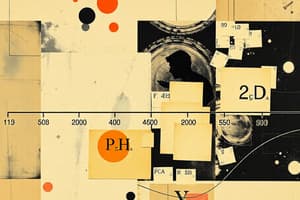Podcast
Questions and Answers
What is the self-ionisation equation of water?
What is the self-ionisation equation of water?
The self-ionisation equation of water is H₂O ↔ H⁺ + OH⁻.
What is the ionic product of water (Kw) at 25°C?
What is the ionic product of water (Kw) at 25°C?
At 25°C, the ionic product of water (Kw) is 1 × 10⁻¹⁴.
How do you calculate pH from hydrogen ion concentration?
How do you calculate pH from hydrogen ion concentration?
pH is calculated using the formula pH = -log₁₀[H⁺].
What is the pH of a solution with a hydrogen ion concentration of 7.1 x 10^-7 mol/L?
What is the pH of a solution with a hydrogen ion concentration of 7.1 x 10^-7 mol/L?
Define a neutral solution in terms of pH.
Define a neutral solution in terms of pH.
What is the equation to calculate pH from hydrogen ion concentration?
What is the equation to calculate pH from hydrogen ion concentration?
Calculate the hydrogen ion concentration when the pH of a solution is 3.7.
Calculate the hydrogen ion concentration when the pH of a solution is 3.7.
What differentiates strong acids from weak acids using the dissociation constant Ka?
What differentiates strong acids from weak acids using the dissociation constant Ka?
Provide an example of a strong base and explain its characteristic.
Provide an example of a strong base and explain its characteristic.
Explain the relationship between strong acids and their conjugate bases.
Explain the relationship between strong acids and their conjugate bases.
How does adding OH^- affect the equilibrium of the indicator reaction?
How does adding OH^- affect the equilibrium of the indicator reaction?
What is the significance of the pH range for an indicator?
What is the significance of the pH range for an indicator?
Describe the setup of a pH titration experiment.
Describe the setup of a pH titration experiment.
What would you observe if H^+ is added to the indicator solution?
What would you observe if H^+ is added to the indicator solution?
How do indicators like methyl orange and phenolphthalein differ in terms of pH range and color change?
How do indicators like methyl orange and phenolphthalein differ in terms of pH range and color change?
What is the pH of a 0.04 M H2SO~4 solution?
What is the pH of a 0.04 M H2SO~4 solution?
Calculate the pH of a 0.15 M NaOH solution.
Calculate the pH of a 0.15 M NaOH solution.
Identify the limitations of the pH scale.
Identify the limitations of the pH scale.
How do you calculate the pH of a weak acid or weak base?
How do you calculate the pH of a weak acid or weak base?
What is the formula for calculating the concentration of H^+ ions from a weak acid?
What is the formula for calculating the concentration of H^+ ions from a weak acid?
Calculate the pH of a 0.1 M solution of methanoic acid with Ka of 2.1 x 10^-4.
Calculate the pH of a 0.1 M solution of methanoic acid with Ka of 2.1 x 10^-4.
Describe the action of an acid-base indicator in a solution.
Describe the action of an acid-base indicator in a solution.
What happens to an acid-base indicator when H^+ ions are added to the solution?
What happens to an acid-base indicator when H^+ ions are added to the solution?
Explain the role of indicators in acid-base titrations and provide an example.
Explain the role of indicators in acid-base titrations and provide an example.
What characterizes a strong acid when titrated against a strong base?
What characterizes a strong acid when titrated against a strong base?
Describe the pH change observed during the titration of a weak acid and a strong base.
Describe the pH change observed during the titration of a weak acid and a strong base.
What is the significance of the conjugate acid-base pair?
What is the significance of the conjugate acid-base pair?
How does the strong dissociation of sulfuric acid differ from that of a weak monobasic acid?
How does the strong dissociation of sulfuric acid differ from that of a weak monobasic acid?
Calculate the pH of a 0.5 M NaOH solution and explain your steps.
Calculate the pH of a 0.5 M NaOH solution and explain your steps.
Why is it not possible to detect the endpoint in a titration of a weak acid with a weak base?
Why is it not possible to detect the endpoint in a titration of a weak acid with a weak base?
State the observed color change when a weak acid indicator is added to a strong base.
State the observed color change when a weak acid indicator is added to a strong base.
Flashcards
Self-ionization of water
Self-ionization of water
The process where water molecules react with each other to produce H+ and OH- ions.
Ionic product of water (Kw)
Ionic product of water (Kw)
The constant that expresses the product of the hydrogen ion and hydroxide ion concentrations in water at a specific temperature.
pH
pH
A measure of the hydrogen ion concentration in a solution, calculated as the negative base-10 logarithm of the hydrogen ion concentration (mol/L).
pH of an acidic solution
pH of an acidic solution
Signup and view all the flashcards
pH of a basic(alkaline) solution
pH of a basic(alkaline) solution
Signup and view all the flashcards
pH of a solution
pH of a solution
Signup and view all the flashcards
Strong Acid
Strong Acid
Signup and view all the flashcards
Weak Acid
Weak Acid
Signup and view all the flashcards
Conjugate Acid-Base Pair
Conjugate Acid-Base Pair
Signup and view all the flashcards
Calculating [H⁺] from pH
Calculating [H⁺] from pH
Signup and view all the flashcards
Indicator Range
Indicator Range
Signup and view all the flashcards
Le Chatelier's Principle (Indicators)
Le Chatelier's Principle (Indicators)
Signup and view all the flashcards
pH Titration
pH Titration
Signup and view all the flashcards
pH Sensor in Titration
pH Sensor in Titration
Signup and view all the flashcards
What is the purpose of a pH titration?
What is the purpose of a pH titration?
Signup and view all the flashcards
pH Titration Curve
pH Titration Curve
Signup and view all the flashcards
End Point
End Point
Signup and view all the flashcards
Strong Acid-Strong Base Titration
Strong Acid-Strong Base Titration
Signup and view all the flashcards
Weak Acid-Strong Base Titration
Weak Acid-Strong Base Titration
Signup and view all the flashcards
Suitable Indicator
Suitable Indicator
Signup and view all the flashcards
Brønsted-Lowry Acid
Brønsted-Lowry Acid
Signup and view all the flashcards
Strong acid pH calculation
Strong acid pH calculation
Signup and view all the flashcards
Strong base pH calculation
Strong base pH calculation
Signup and view all the flashcards
pH scale limitations
pH scale limitations
Signup and view all the flashcards
Weak acid pH calculation
Weak acid pH calculation
Signup and view all the flashcards
Weak base pH calculation
Weak base pH calculation
Signup and view all the flashcards
Acid-base indicator
Acid-base indicator
Signup and view all the flashcards
Indicator color change: Le Chatelier's Principle
Indicator color change: Le Chatelier's Principle
Signup and view all the flashcards
How does an indicator work?
How does an indicator work?
Signup and view all the flashcards
Study Notes
Self-Ionization of Water
- Water conducts electricity when it contains dissolved ions.
- Pure water has a very small current due to self-ionization.
- Water self-ionizes as follows: H₂O → H⁺ + OH⁻
- The concentration of H⁺ and OH⁻ ions in pure water is very small.
- The equilibrium in the self-ionization reaction is strongly to the left.
- The concentration of H₂O remains relatively constant.
- Equilibrium constant (K) can be written as: K = [H⁺][OH⁻]/[H₂O]
- Since [H₂O] is effectively constant, the expression can be simplified to: Kw = [H⁺][OH⁻]
- At 25°C, Kw = 1 x 10⁻¹⁴
- To find [H⁺] given Kw, use the fact [H⁺]=[OH⁻]: [H⁺] = √(1 x 10⁻¹⁴) = 1 x 10⁻⁷ mol/L
pH Scale
- pH is defined as: pH = -log₁₀[H⁺]
- Square brackets indicate concentration in moles per litre.
- pH is the negative logarithm to the base 10 of hydrogen ion concentration.
- pH of a solution is measured in moles per litre.
- pH values range from 0 to 14.
- pH values below 7 are acidic; above 7 are alkaline; 7 is neutral.
Strengths of Acids and Bases
- Strong acid: A good proton donor (e.g., HCl, H₂SO₄)
- Weak acid: A poor proton donor (e.g., ethanoic acid)
- Strong base: A good proton acceptor (e.g., NaOH, KOH)
- Weak base: A poor proton acceptor (e.g., NH₃)
- Acid dissociation constants (Ka) measure acid strength.
- Larger Ka values indicate stronger acids.
- Base dissociation constants (Kb) measure base strength.
- Larger Kb values indicate stronger bases.
Calculating pH of Strong Acids and Bases
- Strong acids and bases are fully dissociated in water.
- The pH of a strong acid solution can be calculated by using the concentration of H+ ions in solution.
- The pH of a strong base solution can be calculated by using the concentration of OH-ions in solution.
Calculating pH of Weak Acids and Bases
- Calculating the pH of a weak acid solution requires consideration of the dissociation constant (Ka).
- The approach uses the equilibrium constant (Ka) and the initial concentration of the weak acid to find the concentration of H+.
- To calculate the pH of a weak acid solution, we must know its dissociation constant.
pH Indicators
- Acid-base indicators: Substances that change color depending on the pH of the solution.
- Indicators have a specific pH range where their color changes.
- Choosing the correct indicator depends on the pH range of the solution being tested.
- Indicator color changes are affected by adding H⁺ or OH⁻ ions according to Le Chatelier's principle.
pH Titration
- A pH titration is an experiment to track pH changes during a titration.
- The process involves adding a base (from a burette) to an acid (in a beaker).
- pH is monitored continuously.
- The pH data is typically plotted as a graph.
- The graph (titration curve) shows how pH changes as the base is added.
- Titration curves for strong acid-strong base, weak acid-strong base and weak acid-weak base reactions have typical shapes.
Studying That Suits You
Use AI to generate personalized quizzes and flashcards to suit your learning preferences.
Related Documents
Description
Explore the self-ionization of water and understand the pH scale through this quiz. You'll learn about the equilibrium constants, the formation of H⁺ and OH⁻ ions, and how pH values indicate acidity or alkalinity. Test your knowledge and see how well you grasp these fundamental concepts in chemistry.




